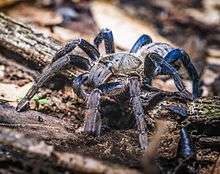Cobalt blue tarantula
| Cobalt blue tarantula | |
|---|---|
 | |
| In Kaeng Krachan District, Phetchaburi, Thailand | |
| Scientific classification | |
| Kingdom: | Animalia |
| Phylum: | Arthropoda |
| Subphylum: | Chelicerata |
| Class: | Arachnida |
| Order: | Araneae |
| Infraorder: | Mygalomorphae |
| Family: | Theraphosidae |
| Genus: | Cyriopagopus |
| Species: | C. lividus |
| Binomial name | |
| Cyriopagopus lividus (Smith, 1996)[1] | |
| Synonyms[1] | |
| |
The cobalt blue tarantula (Cyriopagopus lividus) is a tarantula species (family Theraphosidae) native to Myanmar[1] and over the border into Thailand.[2] It was originally described as Haplopelma lividum.
Description
The cobalt blue tarantula is a medium-sized tarantula with a leg span around 13 cm (5 in). The cobalt blue tarantula is noted for its iridescent blue legs and light gray prosoma and opisthosoma, the latter of which may contain darker gray chevrons.[3] Males and females look the same until the ultimate (final) molt of the males. At this point, the male exhibits sexual dimorphism in the form of a light tan or bronze coloration and legginess. Additionally, males gain a palpal bulb on the pedipalps and tibial apophyses (mating hooks). The female eventually becomes larger than the male and lives years longer.[4] The cobalt blue tarantula is a fossorial species and spends nearly all of its time in deep burrows of its own construction.
 A female (left) and male (right) in courtship in captivity
A female (left) and male (right) in courtship in captivity- A second-instar spiderling cobalt blue tarantula near burrow
Habitat
The cobalt blue tarantula inhabits the tropical rain forests of southeast Asia,[5] where they construct deep burrows, and generally only leave them to find food.
Pets
The cobalt blue tarantula is a mainstay in the pet trade, despite being a fast and defensive tarantula with potent venom.[6] Bites from this species can result in severe muscle cramps and inflammation.[7] Typically, they are kept in a deep tank with 25 to 30 cm (10-12 inches) of substrate such as peat moss or coco-husk that is kept humid.[8]
References
- 1 2 3 "Taxon details Cyriopagopus lividus Smith, 1996", World Spider Catalog, Natural History Museum Bern, retrieved 2017-03-18
- ↑ Ngamniyom, Arin; Manaboon, Manaporn; Panyarachun, Busaba & Showpittapornchai, Udomsri (2014). "Phylogenetic Relationships of Two Earth Tiger Tarantulas, Haplopelma lividum and H. longipes (Araneae, Theraphosidae), within the Infraorder Mygalomorph Using 28S Ribosomal DNA Sequences". International Journal of Zoological Research. 10 (1): 15–19. Retrieved 2016-06-08.
- ↑ Photos of Haplopelma lividum
- ↑ http://www.everything-cobalt-blue.com/cobalt-blue-tarantula.html
- ↑ Smith, A. M. (1996). "A new species of Haplopelma (Araneae: Theraphosidae), with notes on two close relatives". Mygalomorph. 1: 21–32.
- ↑ Takaoka Makoto (2001). "Tarantulas Bite: Two Case Reports of Finger Bite from Haplopelma lividum". The Japanese Journal of Toxicology. 14 (3): 247–250.
- ↑ "Cobalt Blue Tarantula (Haplopelma lividum)". Keeping Exotic Pets. Retrieved 2016-04-03.
- ↑ Schultz, Stanley A. (2009). The Tarantula Keeper's Guide: Comprehensive Information on Care, Housing, and Feeding. Barrons. ISBN 0764138855.
External links
| Wikimedia Commons has media related to Cyriopagopus lividus. |